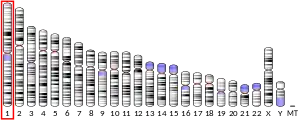Interleukin 20
Interleukin 20 (IL20) is a protein that in humans is encoded by the IL20 gene.[4] Interkeukin 20 also includes other cytokines, including IL-19, IL-20, IL-22, IL-24, and IL-26. Based on common structural and functional properties of IL-20's receptors and target cells, these cytokines constitute the same subfamily, IL-20.[5]
Function
The protein encoded by this gene is a cytokine structurally related to interleukin 10 (IL-10). This cytokine has been shown to transduce its signal through signal transducer and activator of transcription 3 (STAT3) in keratinocytes. A specific receptor for this cytokine is found to be expressed in skin and upregulated dramatically in psoriatic skin, suggesting a role for this protein in epidermal function and psoriasis.[4]
Interleukin-20 (IL-20) is a protein belonging to the IL-10 family of cytokines. IL-20 is produced by activated keratinocytes and monocytes and transmits an intracellular signal through two distinct cell-surface receptor complexes on keratinocytes and other epithelial cells. IL-20 regulates proliferation and differentiation of keratinocytes during inflammation, particularly inflammation associated with the skin. In addition, IL-20 also causes cell expansion of multipotential hematopoietic progenitor cells.[6]
Anti IL-20
Anti-IL-20 monoclonal antibodies have been researched as clinical candidates for the treatment or prevention of psoriasis, rheumatoid arthritis, atherosclerosis, osteoporosis, and stroke.[7][8][9]
References
- GRCh38: Ensembl release 89: ENSG00000162891 - Ensembl, May 2017
- "Human PubMed Reference:". National Center for Biotechnology Information, U.S. National Library of Medicine.
- "Mouse PubMed Reference:". National Center for Biotechnology Information, U.S. National Library of Medicine.
- "Entrez Gene: Interleukin 20".
- Rutz S, Wang X, Ouyang W (Dec 2014). "The IL-20 subfamily of cytokines—from host defence to tissue homeostasis". Nature Reviews. Immunology. 14 (12): 783–95. doi:10.1038/nri3766. PMID 25421700.
- Rich BE, Kupper TS (August 2006). "Interleukin 20". Anti-Inflammatory & Anti-Allergy Agents in Medicinal Chemistry. 5 (3): 243–250. doi:10.2174/187152306778017683.
- Kragstrup TW, Otkjaer K, Holm C, Jørgensen A, Hokland M, Iversen L, Deleuran B (Jan 2008). "The expression of IL-20 and IL-24 and their shared receptors are increased in rheumatoid arthritis and spondyloarthropathy" (PDF). Cytokine. 41 (1): 16–23. doi:10.1016/j.cyto.2007.10.004. PMID 18061474.
- Hsu YH, Chen WY, Chan CH, Wu CH, Sun ZJ, Chang MS (Aug 2011). "Anti-IL-20 monoclonal antibody inhibits the differentiation of osteoclasts and protects against osteoporotic bone loss". The Journal of Experimental Medicine. 208 (9): 1849–61. doi:10.1084/jem.20102234. PMC 3171097. PMID 21844205.
- Kragstrup, Tue Wenzel; Greisen, Stinne Ravn; Nielsen, Morten Aagaard; Rhodes, Christopher; Stengaard-Pedersen, Kristian; Hetland, Merete Lund; Hørslev-Petersen, Kim; Junker, Peter; Østergaard, Mikkel; Hvid, Malene; Vorup-Jensen, Thomas; Robinson, William H.; Sokolove, Jeremy; Deleuran, Bent (11 March 2016). "The interleukin-20 receptor axis in early rheumatoid arthritis: novel links between disease-associated autoantibodies and radiographic progression". Arthritis Research & Therapy. 18 (1): 61. doi:10.1186/s13075-016-0964-7. PMC 4788924. PMID 26968800.
External links
- Overview of all the structural information available in the PDB for UniProt: Q9NYY1 (Interleukin-20) at the PDBe-KB.
This article incorporates text from the United States National Library of Medicine, which is in the public domain.

